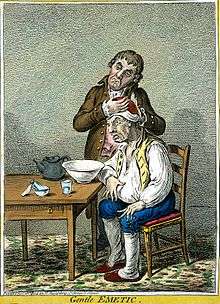Heroic medicine

Caricature of a purging treatment (James Gillray, 1804)
Heroic medicine was the tradition in European medicine that encouraged the use of treatments with an immediate and dramatic effect, even at substantial risk to the patient. The treatments most commonly used were bloodletting and purging of the digestive tract. Heroic methods dominated medical practice in the 18th and early 19th centuries, but were displaced from the mid-19th century onward by the rival "conservative" approach.[1]
During what has been called the "Age of Heroic Medicine" (1780–1850),[2] educated professional physicians made extensive use of bloodletting (venesection[2]), intestinal purging (calomel), vomiting (tartar emetic), profuse sweating (diaphoretics) and blistering, stressing already weakened bodies.[3]
See also
References
- ↑ Flint, August (1874) Essays on Conservative Medicine
- 1 2 Weil, Andrew (2004). Health and healing: the philosophy of integrative medicine. Houghton Mifflin Harcourt. p. 12. ISBN 978-0-618-47908-5.
- ↑ Singh, Simon; Ernst, Edzard (2008). Trick Or Treatment: The Undeniable Facts about Alternative Medicine. W. W. Norton & Company. p. 108. ISBN 978-0-393-06661-6.
This article is issued from Wikipedia - version of the 10/30/2016. The text is available under the Creative Commons Attribution/Share Alike but additional terms may apply for the media files.